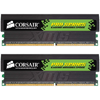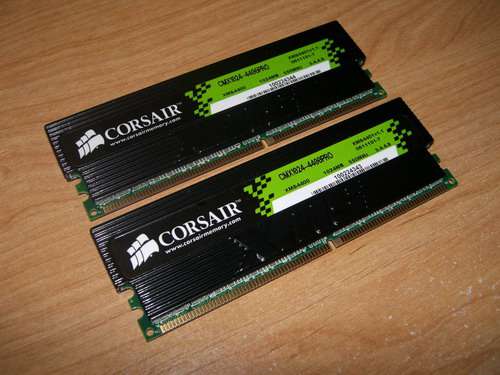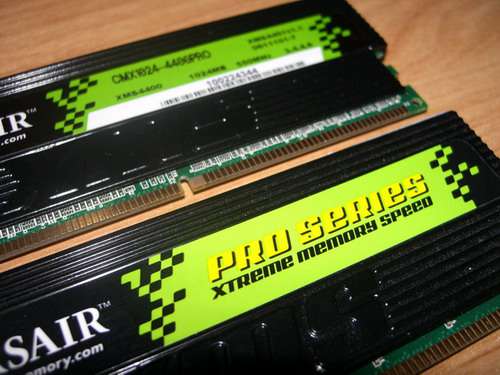- Qualcomm Launches Snapdragon 4 Gen 2 Mobile Platform
- AMD Launches Ryzen PRO 7000 Series Mobile & Desktop Platform
- Intel Launches Sleek Single-Slot Arc Pro A60 Workstation Graphics Card
- NVIDIA Announces Latest Ada Lovelace Additions: GeForce RTX 4060 Ti & RTX 4060
- Maxon Redshift With AMD Radeon GPU Rendering Support Now Available
Corsair 2GB TWINX2048-4400PRO

Corsair once again wants the top spot in the DDR market, and they have it. The 4400PRO is the only 2GB kit available at these speeds, which is reason enough to check them out. Well, they prove very fast as we had hoped, despite the somewhat loose timings. Let’s take a deeper look.
Page 2 – Speed? What speed?
As mentioned in the intro, this is currently the only 2GB DDR550 kit on the market. Of course that doesn’t happen without loose timings, which are 3-4-4-8 in this case. These timings are actually quite impressive still, because many 2GB DDR500 kits out there use the exact same timings. 50MHz more while keeping the same timings? I’m there.
For these modules, Corsair chose to use Infineon CE-5. I am unsure the -exact- chip codes, however. Infineon was a good choice for the modules, because they can handle great speeds alongside with great timings. However, CE-5 and CE-6 can be very troublesome at times. To say the least, CE-5 can be fussy.. very fussy. In some motherboards it will work as you expect it should, but in others, you may get some far different results.
Enter DFI Ultra-D.
This is one motherboard I have loved ever since it’s release. It’s not only a solid motherboard, but it offers just what the enthusiast and overclocker wants. One problem with the board though, is that it is hit and miss with memory. For example, when I got my first Ultra-D (before I killed two), I had issues getting MemTest error free with Micron based modules. The modules proved completely stable, only in that MemTest would cause errors.
Then came GeIL Ultra-X 1GB PC3200. This memory is said to work in the Ultra-D, but once installed, my system will not boot. If it does manage to boot, it gets stuck in an endless loop. So needless to say, the Ultra-D is picky. The reason I am mentioning all of this, is because that prior to receiving the 4400PRO, I was well aware that there were some issues with the Ultra-D and Infineon CE-5 and CE-6.
The primary problem with these chips is that the Ultra-D will not usually be 3D Stable, meaning game stable, at high overclocks. Over course, these modules are not ‘overclocked’ per se, but they roll in with bleeding edge speeds, so the potential for problem is there.
I should note that this is not just specific to Ultra-D boards, and I am not trying to single it out. However, most people who also have had these problems with their kits, have coincidently owned an Ultra-D or an SLI-DR. You could run into these problems regardless of what motherboard you run.
That potential became a reality during my testing. At the stock speeds of 275MHz, 3-4-4-8 2T, all synthetic benchmarks would be 100% stable, but as soon as I loaded up a game I would have a problem. Infineon tends to also be very specific in what it likes. It may only take a few MHz to make a world of difference, and in my case that proved true. After a night of tweaking, I found 272MHz with 3-3-2-0 timings to be completely 100% 3D Stable. It was a matter of only 3MHz that made the memory 3D Stable. In addition, the tighter timings are a welcomed advantage.
So what you want to take from this, is that if you purchase these modules, don’t be surprised if you cannot run 3D Stable at stock speeds. Rather, it may be a difference of 5MHz. Even at 270MHz, these modules prove very fast. It’s not the fault of the modules that these problems are consistent, but rather the CE-5 chips and/or the motherboard.
In tests performed by Corsair, it seemed that modules that proved 3D Unstable at stock speeds in an ASUS motherboard, proved stable in the DFI. On the other hand, they had a few modules that proved 100% 3D stable in the DFI, and not 3D stable in the ASUS. Talk about hit or miss!
Enough of my dribble. Let’s get straight into the overclock ability of these babies.
|
|
Support our efforts! With ad revenue at an all-time low for written websites, we're relying more than ever on reader support to help us continue putting so much effort into this type of content. You can support us by becoming a Patron, or by using our Amazon shopping affiliate links listed through our articles. Thanks for your support!







